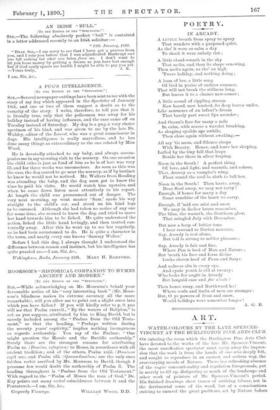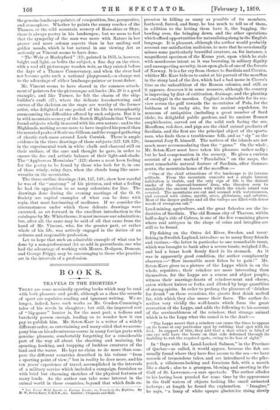ART.
WATER-COLOURS BY THE LATE SPENCER. VINCENT AT THE BURLINGTON FINE ARTS CLUB.
ON entering the room which the Burlington Fine Arts Club have devoted to the works of the late Mr. Spencer-Vincent, the most unreflective spectator must carry away the impres- sion that the work is from the hands of one who deeply felt, and sought to reproduce in an earnest and serious way, the ever-varying moods of Nature. There is a refreshing absence of the vague conventionality and regulation foregrounds, put in merely to fill up, disfiguring so much of the landscape and other work of painters of Mr. Spencer-Vincent's period. His finished drawings show traces of untiring labour, not in the detrimental sense of the word, but of a conscientious striving to unravel the great problems, set by Nature before
the genuine landscape-painter, of composition, line, perspective, and atmosphere. Whether he paints the sunny reaches of the Thames, or the wild mountain scenery of Ross-shire or Skye, there is always poetry in his landscapes ; but we seem to feel that the sympathy of the man was more with Nature in her graver and more solemn aspects than in her smiling and golden moods, which is but natural in one viewing Art as seriously as Vincent seems to have done.
"The Weir at Harleyford " (13), painted in 1855, is, however, bright and light, as befits the subject, a fine day on the river, with a real old picturesque wooden weir, as they existed before the days of a Thames Conservancy, and when the river had not become quite such a national playground,—a change not to the advantage of either landscape-painter or trout-fisher.
Mr. Vincent seems to have shared in the common attach- ment of painters for the picturesque eel-bucks (No. 29 is a good example), and like Turner, he felt the charm of the ship- builder's craft (37), where the delicate foreshortening and curves of the skeleton on the stays are worthy of the former artist, who delighted at one period of his life in triumphantly surmounting the difficulties offered by such subjects. But it is in wild mountain scenery of the Scotch Highlands that Vincent found subjects wholly in accord with his own nature ; and in the Highlands, nothing seems more to have inspired his pencil than the serrated peaks of Scuir-na-Gillean, and the rugged gathering of chaotic rock-mass around Loch Coruisk. There is ample evidence in the three drawings of these subjects (1-27, 128,129), in the experimental work in white chalk and charcoal still on their surface, of the care and thought he gave, in order to ensure the due and artistic balance of their light-and-shade. The "Applecross Mountains" (121) shows a most keen feeling for the poetry to be found by those who look for it, in one of those windy, rainy days, when the clouds hang like snow- wreaths on the mountains.
The three outline drawings (146, 147, 148), show how careful he was of the " anatomy " of his pictures, and what a feeling he had (in opposition to so many colourists) for line. The drawings done during the evening meetings of the 0. 0. Society are capital examples of what can be done with sepia, that most fascinating of mediums. If we consider the circumstances under which these delicate drawings were executed, as set forward in the excellent introduction to the catalogue by Mr. Whitethorne, it must increase our admiration; but, after all, the same may be said of all that came from the hand of Mr. Vincent, who, for the greater part, or rather whole of his life, was actively engaged in the duties of an arduous and responsible profession.
Let us hope that such an admirable example of what can be done by a non-professional (let us add in parenthesis, one who had the advantage of working with Messrs. Dodgson, Duncan, and George Fripp), may be encouraging to those who practise art in the intervals of a profession.



































 Previous page
Previous page